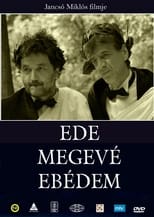

András Szirtes
Movies for András Szirtes...



Title: Ed's Eaten Elevenses
Character: Film director
Released: October 12, 2006
Type: Movie
Jancsó’s farce, similar to the previous ones, is about our time and about death. Pepe marries into a family of mafiosi, with the father-in-law rolling in money. In a joint venture they establish the first Hungarian Prison Limited company, where there is a menu, the prisoners are residents, and they furnish the place of execution for those volunteering to execute themselves. It turns out that the first voluntary hanging should be demonstrated on Pepe. In 180 AD Emperor Marcus Aurelius is dying in Vindobona, being fed with blades of hay by uncle Miki himself, and his son Kornél Mundruczó. Kapa provides for communication: he insists on telling lies, lies and again lies. Furthermore, there are several to die and to revive, to win and to lose, and Melancholy Béla is still alive.


Title: The Battle of Mohács
Character: Professor Szirtes
Released: February 26, 2004
Type: Movie
By the notes of Fiáth Pompeiusz, the one-time friend of Kapa and Pepe, Professor Szirtes has solved the secret of the time machine, and he realizes the invention relying on "special" H2O. Kapa and Pepe shall return by it into the past in order to set time right, which is out of joint, that is, to correct history, to save King Louis II, and prevent the Mohács Disaster. Pepe yields to the not too tender persuasion to enter upon the great journey through time, dies and revives, and they arrive at the battlefield of Mohács in time. Kapa films the events. The Turks win and cut off the king’s, Pepe’s, head, still the Hungarians dictate the peace treaty. Kapa and Pepe want to return, they fill the time machine up with water from the well, yet it won’t start. Even so Kapa and Pepe hover over Budapest and quarrel.


Title: Lenz
Released: January 1, 1986
Type: Movie
This experimental film, reminiscent of Csontváry's paintings, creates the character of the "Lenz" of the 20th century. The hyper-sensitive polihistor of the second millennium is no romantic, literary man suffering from schizophrenia, but a nuclear scientist suffering from radio-active contamination. Lenz is sent to rest to the mountains by his doctor.


Title: The History of the Pronuma Clusters
Released: July 7, 1983
Type: Movie
The film is a series of sketches in the genre of the happening, describing the state of mind of grass-roots intellectuals during the early 80s. In situation games, six people portray their environ-ment purely by the tools of the pantomime, in a visual, meta-communicative way. The absurdity of the world is shown in a fullness typical for the childhood world of the protagonist, a young teenage girl. This absurdity is just as much present in faceless bureaucracy, social deviation, atomisation, wars and the scenes of diplomacy fighting a perfect Babel, as it is there in the soon to disappear spheres of intimacy, i.e. scenes of love, family and leisure, interwind in each other. The scene of the leaf swarming with Pronuma clusters also proves the same.
